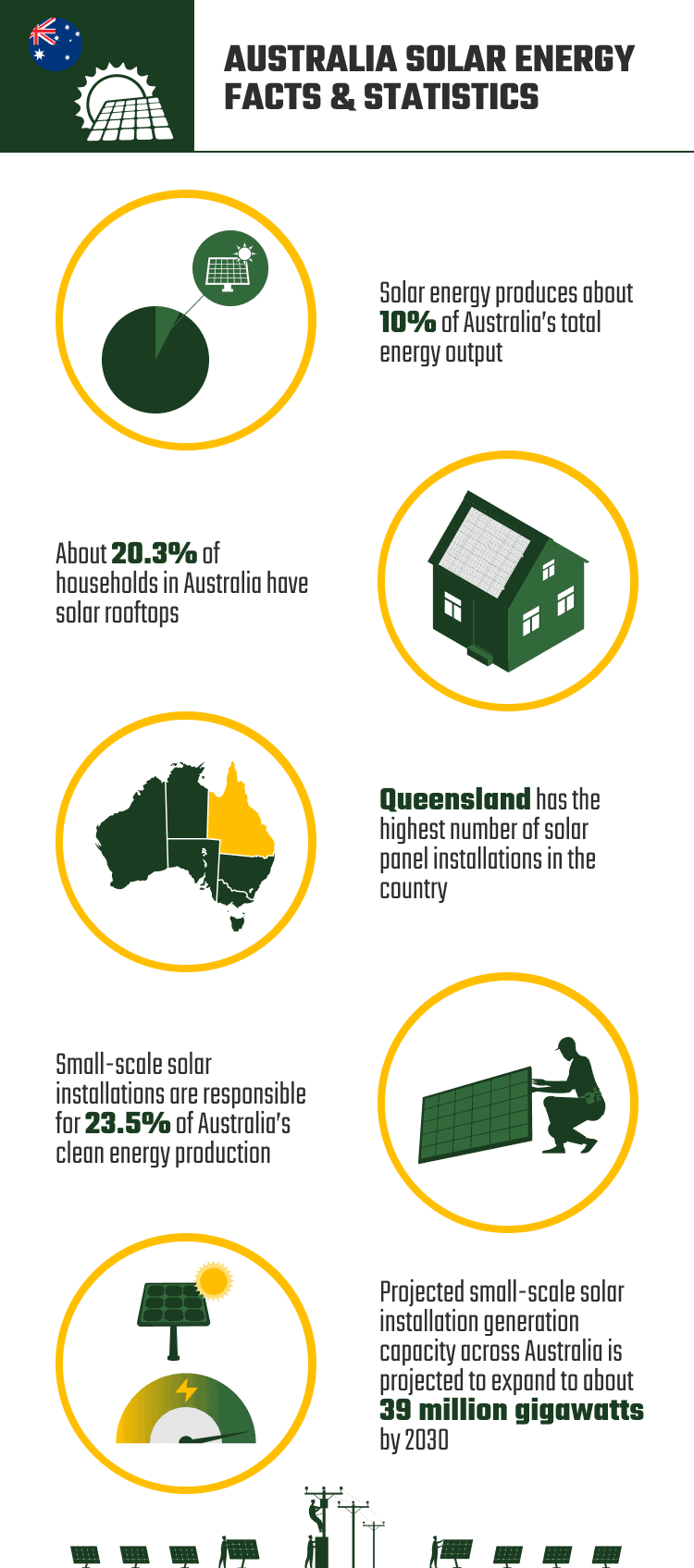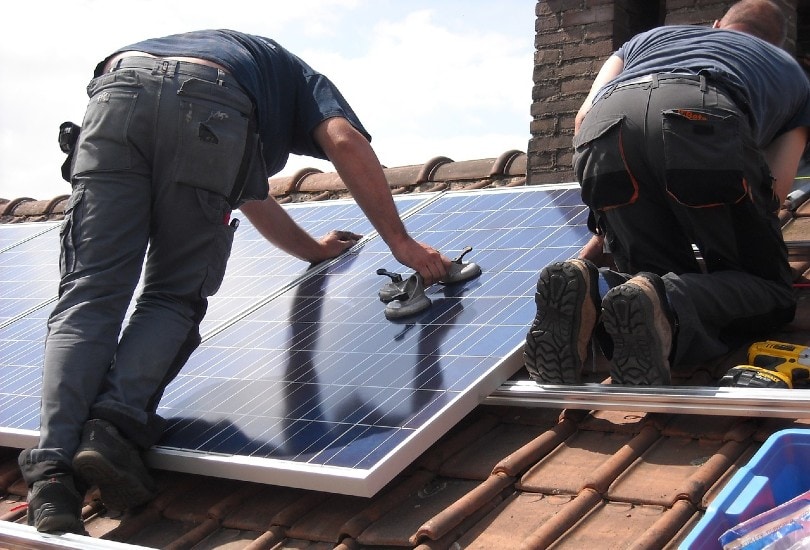11 Solar Energy Statistics in Australia (2025 Update)
-
Codee Chessher
- Last updated:

Note: This article’s statistics come from third-party sources and do not represent the opinions of this website.
Solar power is becoming extremely popular across the globe, and some countries are better suited to take advantage than others. With vast expanses of sunny brushland, Australia seems to be a great place for solar power. Unsurprisingly, it is! Let’s check out some interesting facts and stats about solar power in Australia.
Click below to jump ahead:
The 11 Solar Energy Statistics in Australia
- Solar energy produced about 10% of Australia’s total energy output in 2020 and 2021.
- Solar energy produced in Australia accounts for only 0.1% of the country’s energy consumption.
- About 20.3% of households in Australia have solar rooftops.
- Queensland has the highest number of solar panel installations in the country.
- Solar energy causes significant drops in energy prices.
- Small-scale solar installations were responsible for 23.5% of Australia’s clean energy production.
- Solar installations in Australia have steadily increased in capacity over the past decade.
- Projected small-scale solar installation generation capacity across Australia is projected to expand to about 39 million gigawatts by 2030.
- The projected large-scale solar installation generation capacity in Australia is expected to swell to 10 million gigawatts by 2030.
- Solar energy produces more electricity than other renewables in Australia.
- Compared to solar, coal and gas comprise 76% of energy production in Australia.

Solar Energy in Australia
1. Solar energy produced about 12% of Australia’s total energy output in 2020 and 2021.
Solar power has become a huge industry around the world, but Australia is a world leader. It produces the third most solar power in the world, although it can’t compete with China or the US. Total energy output is much higher than this figure, so solar power isn’t actually used as much as you’d think.
(RegalGrid)

2. Solar energy produced in Australia accounts for only 0.1% of the country’s energy consumption.
Despite so much solar power being generated in the country, Australia uses very little of the power it produces. This is largely because solar power isn’t viable for industrial applications, which rely on fossil fuel-based fuels like coal and natural gas. As solar power evolves, we could see this number spiking upward in the next decade or two.
(Clean Energy Council)
3. About 20.3% of households in Australia have solar rooftops.
The vast majority of Australia’s solar power comes from small-scale installations on residential rooftops across the country. This is mainly because solar power isn’t yet feasible for industrial purposes. As awareness about solar energy and its benefits spreads, everyone expects this number to rise sharply in future years.
(RegalGrid)

4. Queensland has the highest number of solar panel installations in the country.
Queensland has some of the largest concentrations of people in Australia. The Gold Coast has the most people, while Brisbane follows close behind. Government tax rebates for installing solar systems on homes help drive this number higher, with the rebate covering 50% of the cost of a new solar system.
(Clean Energy Australia Report 2019)
About Solar Energy
5. Solar energy causes significant drops in energy prices.
Increased energy production naturally drives down prices via supply and demand, and areas like Tasmania saw the greatest benefit from price reductions as recently as 2020. Unfortunately, coal companies increased prices after this drop, which minimized the monetary benefit for Australians. As reliance on coal power decreases, Australians will see greater price reductions from more solar production. Unfortunately, coal companies have more power to influence the market at present.
(SolarFeeds)

6. Small-scale solar installations were responsible for 23.5% of Australia’s clean energy production.
This figure includes all clean energy production, from solar to hydro, geothermal, and biomass energy production efforts. Notably, burning renewable biomass in brushlands was a significant source of renewable energy for the country. As more people become aware of how useful solar is, even in the desert, we expect solar to overtake all other renewable energy sources.
(Statista)
7. Solar installations in Australia have steadily increased in capacity over the past decade.
With continuous improvements in solar energy technology, both small and large-scale solar panels have increased exponentially since 2010. Costs have also dropped by over 80% for PV solar panel systems, which allows more and more people to take advantage of
(Statista)

8. Projected small-scale solar installation generation capacity across Australia is projected to expand to about 39 million gigawatts by 2030.
Although they’re less efficient than large-scale systems, small-scale solar arrays are the most popular type for residential homes across Australia. They benefit from government tax rebates for new systems and produce much less energy than solar farms. However, small-scale systems are perfect for households and will likely continue to be the system of choice for most Australians.
(Statista)
9. The projected large-scale solar installation generation capacity in Australia is expected to swell to 10 million gigawatts by 2030.
Although it’s still not as widely used as coal for industrial purposes, large-scale solar farms are gaining popularity in the uninhabited zones of Australia. The country receives a huge amount of solar radiation, largely unharnessed, and continuing to build solar farms could help reduce dependency on fossil fuels in the future. Ideally, the goal is to generate 100% renewable power, but that goal remains out of reach for the time being.
(Statista)

Solar Energy vs. Other Energy Sources
10. Solar energy produces more electricity than other renewables in Australia.
Solar power comprises 12% of energy generation in Australia, with other renewables lagging. Australia leads the world in wind power, but solar power continues to outpace it in terms of energy production. Overall, wind power simply can’t compete in Australia because the country receives more solar energy than wind annually.
(GeoScience Australia)
11. Compared to solar, coal and gas comprise 76% of energy production in Australia.
Like most of the world, fossil fuels have a stranglehold on energy production in Australia. Even when consumers enjoyed lower energy prices after solar was widely adopted, coal companies simply raised prices in response to stabilize the market. Until coal and gas are phased out in industry across the country, Australia will be at the mercy of those companies.
(Australian Government Department of Climate Change, Energy, the Environment, and Water)

Frequently Asked Questions About Solar Energy in Australia
What size solar-energy system should I use for a home in Australia?
For an average-sized house with two or more bedrooms, a 6–8-kilowatt system is plenty. These systems are stock standard across the globe for satisfying most households’ energy requirements. If you exceed your home’s energy needs, you can typically sell the excess energy back to the power grid, but this may vary based on your state.
How reliable are solar panels?
Solar panels have no moving parts, which means they’re unlikely to wear out prematurely. Most panels have a lifespan of 25 years or more, while solar batteries may only last 5–15 years at most. The panels themselves are often the most expensive part of a solar installation, so it’s a fairly good investment that will save you money in the long term. Especially in Australia, solar power is ample and only predicted to grow in the future.
What tax benefits can I take advantage of by installing solar in Australia?
Under the Sustainable Household Scheme (SHT), homeowners and small businesses can take advantage of 0% interest loans to install solar systems as well as a 50% rebate toward new solar installations. By installing new systems, you create Small-scale Technology Certificates (STCs) that can be used to discount energy costs or sold outright for money.

Do solar panels increase home value in Australia?
Yes! Like everywhere else, having a solar system installed will instantly boost your home value in Australia. Estimates say that Aussies can boost their home’s value by as much as $6,000 by installing a typical solar panel array. This is especially attractive because you can take immediate advantage of the panels while planning to sell the home at a later date.
Is there a free solar program in Australia?
Yes, there is a free low-income program in Australia. The Solar for Low-Income Households program provides low-income households with 3-kilowatt solar panel systems to help reduce energy costs. Government estimates say this system can save households as much as $600 per year. Check this website¹ to see if you qualify for the program.
How much solar radiation does Australia get?
Australia receives 58 million petajoules (PJs) of solar radiation per year, which is more than 10,000 times how much energy the country uses annually. Although the country uses very little of its solar power, future widespread adoption of solar power could see this number ballooning very soon. By harnessing the huge expanses of empty, sunny land, Australia could easily break its dependence on fossil fuels.
Conclusion
Solar power is set to become a major source of power in future decades, and Australia is poised to become a world leader. Although industry lags behind with reliance on fossil fuels, small-scale solar systems are growing exponentially.
Featured Image Credit: Pixabay
Contents
